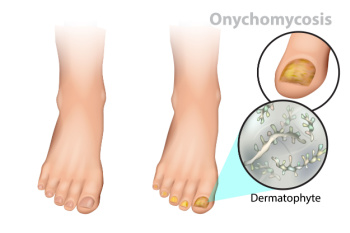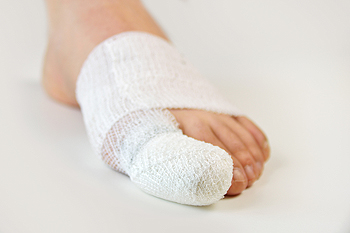Items filtered by date: September 2024
Understanding Toenail Fungal Infections in Children

Fungal toenail infections in kids, also known as onychomycosis, occur when fungi grow in or under the nail, leading to discoloration, thickening, and brittleness. These infections thrive in warm and moist environments, making locker rooms, public pools, and tight-fitting shoes common sources of exposure. Children with weakened immune systems or those prone to athlete’s foot are more susceptible to fungal infections. If your child develops a fungal toenail infection, maintaining proper foot hygiene is essential. Keep their feet clean and dry, and ensure they wear breathable shoes and change socks regularly. If your child’s toenail becomes painful or if multiple nails are affected, it is suggested that you consult a podiatrist.
If left untreated, toenail fungus may spread to other toenails, skin, or even fingernails. If you suspect you have toenail fungus it is important to seek treatment right away. For more information about treatment, contact Richard P. Jacoby, DPM of Extremity Health Centers. Our doctor can provide the care you need to keep you pain-free and on your feet.
Symptoms
- Warped or oddly shaped nails
- Yellowish nails
- Loose/separated nail
- Buildup of bits and pieces of nail fragments under the nail
- Brittle, broken, thickened nail
Treatment
If self-care strategies and over-the-counter medications does not help your fungus, your podiatrist may give you a prescription drug instead. Even if you find relief from your toenail fungus symptoms, you may experience a repeat infection in the future.
Prevention
In order to prevent getting toenail fungus in the future, you should always make sure to wash your feet with soap and water. After washing, it is important to dry your feet thoroughly especially in between the toes. When trimming your toenails, be sure to trim straight across instead of in a rounded shape. It is crucial not to cover up discolored nails with nail polish because that will prevent your nail from being able to “breathe”.
In some cases, surgical procedure may be needed to remove the toenail fungus. Consult with your podiatrist about the best treatment options for your case of toenail fungus.
If you have any questions, please feel free to contact one of our offices located in Scottsdale and Buckeye, AZ . We offer the newest diagnostic and treatment technologies for all your foot care needs.
Arthritis Can Cause Pain in the Feet and Ankles
Better Foot Health for Athletes

Athletes rely heavily on their feet to perform at their best, making foot health a top priority. Choosing the right footwear is essential for support, stability, and cushioning, reducing the risk of injury. Properly fitted shoes prevent discomfort and pain caused by ill-fitting options. Socks also play a vital role, providing a barrier against moisture and bacteria, which can lead to infections. Overtraining or increasing workout intensity too quickly can strain the feet, leading to conditions like stress fractures or muscle strains. Incorporating foot exercises and stretches can strengthen the muscles, improve flexibility and increase resilience. If foot pain occurs, it is important to listen to your body and seek help from a podiatrist. This medically trained foot doctor can offer expert advice on injury prevention, diagnose underlying issues, and provide treatment to keep you active. If you have foot problems that impede your ability to work out, it is suggested that you schedule an appointment with a podiatrist.
Everyday foot care is very important to prevent infection and other foot ailments. If you need your feet checked, contact Richard P. Jacoby, DPM from Extremity Health Centers. Our doctor can provide the care you need to keep you pain-free and on your feet.
Everyday Foot Care
Often, people take care of their bodies, face and hair more so than they do for their feet. But the feet are a very important aspect of our bodies, and one that we should pay more attention to. Without our feet, we would not be able to perform most daily tasks.
It is best to check your feet regularly to make sure there are no new bruises or cuts that you may not have noticed before. For dry feet, moisturizer can easily be a remedy and can be applied as often as necessary to the affected areas. Wearing shoes that fit well can also help you maintain good foot health, as well as making it easier to walk and do daily activities without the stress or pain of ill-fitting shoes, high heels, or even flip flops. Wearing clean socks with closed shoes is important to ensure that sweat and bacteria do not accumulate within the shoe. Clean socks help to prevent Athlete’s foot, fungi problems, bad odors, and can absorb sweat.
If you have any questions please feel free to contact one of our offices located in Scottsdale and Buckeye, AZ . We offer the newest diagnostic and treatment technologies for all your foot and ankle needs.
Causes of Discoloration in Elderly Feet

Discoloration of the feet in elderly adults, such as purple, black, or blue hues, often signals underlying health issues. These colors can result from bruising due to minor trauma or falls, which may be more common in those with fragile skin and weakened blood vessels. Poor circulation or conditions like peripheral artery disease can also cause the feet to appear discolored, as blood flow becomes restricted. Additionally, venous insufficiency can lead to the pooling of blood and subsequent color changes. In some cases, these symptoms might indicate more serious concerns, such as blood clots or infections. It is vital for elderly individuals experiencing these symptoms to seek medical attention from a podiatrist to determine the cause and receive appropriate treatment. If you are elderly or caring for an elderly person, it is suggested that you are under the care of a podiatrist who can regularly monitor foot health.
Proper foot care is something many older adults forget to consider. If you have any concerns about your feet and ankles, contact Richard P. Jacoby, DPM from Extremity Health Centers. Our doctor can provide the care you need to keep you pain-free and on your feet.
The Elderly and Their Feet
As we age we start to notice many changes in our body, but the elder population may not notice them right away. Medical conditions may prevent the elderly to take notice of their foot health right away. Poor vision is a lead contributor to not taking action for the elderly.
Common Conditions
- Neuropathy – can reduce feeling in the feet and can hide many life-threatening medical conditions.
- Reduced flexibility – prevents the ability of proper toenail trimming, and foot cleaning. If left untreated, it may lead to further medical issues.
- Foot sores – amongst the older population can be serious before they are discovered. Some of the problematic conditions they may face are:
- Gouging toenails affecting nearby toe
- Shoes that don’t fit properly
- Pressure sores
- Loss of circulation in legs & feet
- Edema & swelling of feet and ankles
Susceptible Infections
Diabetes and poor circulation can cause general loss of sensitivity over the years, turning a simple cut into a serious issue.
If you have any questions please feel free to contact one of our offices located in Scottsdale and Buckeye, AZ . We offer the newest diagnostic and treatment technologies for all your foot and ankle needs.
Walking With a Broken Toe

Walking with a broken big toe can be incredibly painful and may hinder your daily activities. Despite the discomfort, many people continue to walk with a broken toe, which can lead to complications like improper healing or worsening the injury. While it is tempting to tough it out, seeking professional medical care is important. A podiatrist can assess the severity of the break, determine whether the bone is aligned, and suggest appropriate treatment. Depending on the injury, this may include buddy taping the toe to an adjacent one, using a splint, or even recommending a specialized shoe to reduce pressure. This may also help to protect the toe and allow proper healing. Ignoring a broken big toe can lead to chronic pain, deformities, or arthritis in the joint. Your podiatrist can provide guidance on when it is safe to resume normal activities to avoid re-injury. If you have a broken big toe, it is suggested that you schedule an appointment with a podiatrist for an exam and treatment.
A broken toe can be very painful and lead to complications if not properly fixed. If you have any concerns about your feet, contact Richard P. Jacoby, DPM from Extremity Health Centers. Our doctor will treat your foot and ankle needs.
What to Know About a Broken Toe
Although most people try to avoid foot trauma such as banging, stubbing, or dropping heavy objects on their feet, the unfortunate fact is that it is a common occurrence. Given the fact that toes are positioned in front of the feet, they typically sustain the brunt of such trauma. When trauma occurs to a toe, the result can be a painful break (fracture).
Symptoms of a Broken Toe
- Throbbing pain
- Swelling
- Bruising on the skin and toenail
- The inability to move the toe
- Toe appears crooked or disfigured
- Tingling or numbness in the toe
Generally, it is best to stay off of the injured toe with the affected foot elevated.
Severe toe fractures may be treated with a splint, cast, and in some cases, minor surgery. Due to its position and the pressure it endures with daily activity, future complications can occur if the big toe is not properly treated.
If you have any questions please feel free to contact one of our offices located in Scottsdale and Buckeye, AZ . We offer the newest diagnostic and treatment technologies for all your foot and ankle needs.

